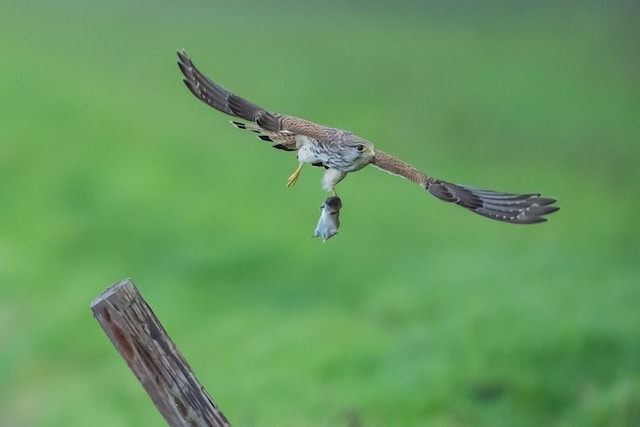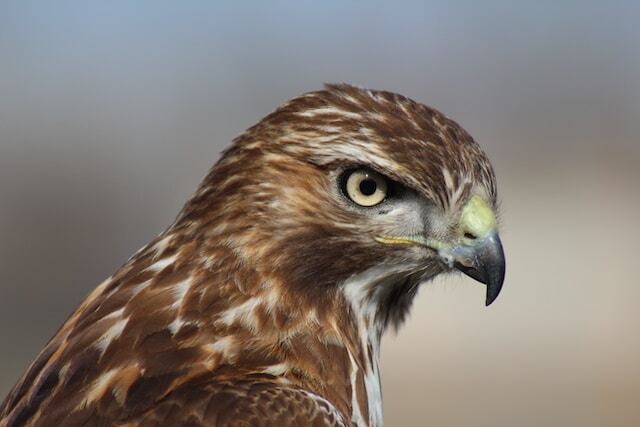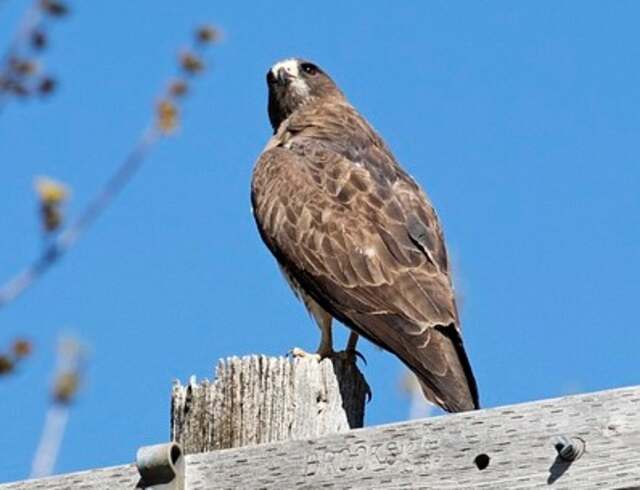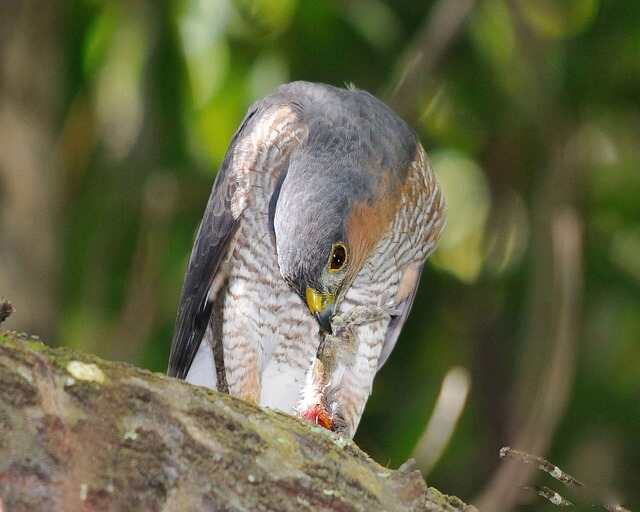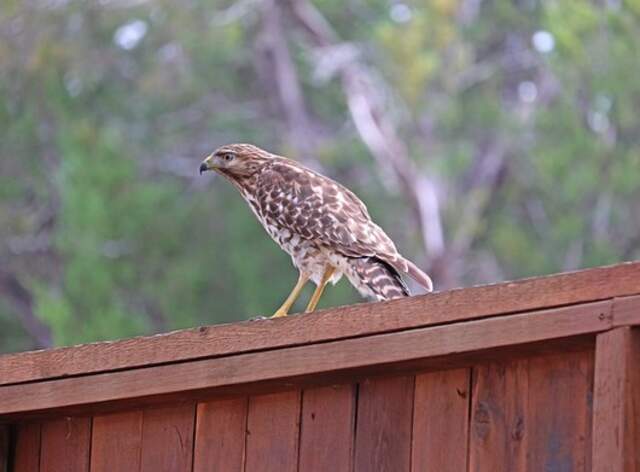Hawks and owls are two of the most fascinating birds of prey in the world. They are both skilled hunters, with sharp talons and keen eyesight that enable them to capture their prey with ease.
Despite their similarities, many people wonder whether these two species get along in the wild.
This article will explore the relationship between hawks and owls and answer the question, do hawks and owls get along? To begin with, it is important to understand the habitat preferences of hawks and owls.
Hawks are typically found in open areas such as grasslands, deserts, and agricultural fields, while owls prefer forested areas.
This means that hawks and owls are unlikely to compete for resources in their respective habitats.
However, there are some exceptions, such as the northern goshawk and the great horned owl, which are known to share the same habitat and compete for prey.
As we delve deeper into their interactions in the wild, we will explore how these birds coexist and what factors contribute to their ability to do so.
Table of Contents
- 1 Key Takeaways
- 2 Do Hawks And Owls Get Along?
- 3 Overview of Hawks and Owls
- 4 Habitat Preferences
- 5 Competition for Resources
- 6 Interactions in the Wild
- 7 Mutual Benefits
- 8 Differences in Hunting Strategies
- 9 Adaptations for Survival
- 10 Threats to their Survival
- 11 Conservation Efforts
- 12 Frequently Asked Questions
- 12.1 How do hawks and owls communicate with each other in the wild?
- 12.2 Can hawks and owls hybridize and produce offspring?
- 12.3 Do hawks and owls migrate to different locations during different times of the year?
- 12.4 How do hawks and owls defend their nests from predators other than each other?
- 12.5 Are there any cultural or mythological beliefs surrounding hawks and owls in different societies?
- 13 Conclusion
- 14 Author
Key Takeaways
- Hawks and owls have different preferences and adaptations, but can coexist in the same habitat.
- Competition and aggression between hawks and owls are common, but cooperative hunting has also been observed.
- Habitat loss and fragmentation are significant threats to their ability to coexist, but conservation efforts can help protect these birds.
- The presence of hawks and owls in a shared habitat can lead to increased biodiversity and ecosystem stability.
Do Hawks And Owls Get Along?
Hawks and owls generally do not get along due to their different hunting strategies and territorial behaviors. Hawks are diurnal hunters, while owls are nocturnal.
They occupy distinct niches and compete for resources, leading to occasional conflicts. However, there have been rare instances of cooperation, such as hawks driving away potential threats to owl nests.
Overall, their relationship is characterized by competition rather than camaraderie.
Overview of Hawks and Owls
An overview of hawks and owls reveals distinct physical and behavioral differences between the two bird species.
Hawks are generally smaller than owls, with sharper, curved beaks and long, narrow wings that allow for fast, agile flight.
Owls, on the other hand, have rounder heads, larger eyes, and softer, less-hooked beaks. They also have larger wingspans, which allows them to fly more silently and slowly than hawks.
In terms of behavior, hawks are diurnal hunters, meaning they hunt during the day, while owls are nocturnal hunters, hunting at night.
Hawks tend to hunt by chasing and catching their prey in mid-air, while owls use their silent flight and sharp talons to swoop down and capture prey from the ground or water.
Despite their differences, both hawks and owls are skilled and efficient hunters in their own right.
Moving onto habitat preferences…
Habitat Preferences
Regarding the preferences for habitats, hawks and owls are like two different species of birds that inhabit completely contrasting worlds, much like fire and ice.
Hawks are diurnal birds of prey that prefer open spaces such as grasslands, deserts, and forests. They usually nest in trees or cliffs and migrate seasonally to find more favorable hunting grounds.
In contrast, owls are nocturnal predators that prefer dense forests, woodlands, and wetlands. They are solitary birds that nest in tree cavities, abandoned buildings, or on the ground.
Owls are also known to be non-migratory, except for some species that move to avoid harsh weather conditions.
The stark contrast in habitat preferences between hawks and owls reduces the chance of direct competition for resources.
However, the differences in their nesting habits and seasonal migrations can still affect their interactions with each other and other species in their respective habitats.
Competition for Resources
The competition for resources between hawks and owls can have a significant impact on the survival and population dynamics of each species, highlighting the importance of understanding their ecological interactions.
In the wild, hawks and owls compete for resources such as food and nesting sites. As food scarcity increases, the competition between them becomes more intense, leading to changes in their behavior and even their distribution.
Climate change has also affected the availability of resources for these birds, with shifting prey populations and habitat loss altering the dynamics of their interactions.
Understanding how hawks and owls compete for resources is crucial for their conservation and management, as it can help identify potential threats and inform effective conservation strategies.
In the next section, we will explore the different interactions that occur between hawks and owls in their natural habitat.
Interactions in the Wild
Interactions in the wild are complex and dynamic, influenced by a variety of factors such as aggression and territorial disputes, as well as cooperative hunting.
Aggression and territorial disputes can result in intense and sometimes lethal conflicts between individuals or groups of animals.
In contrast, cooperative hunting can involve individuals working together to increase their chances of capturing prey or defending their territory.
Aggression and territorial disputes
Aggression and territorial disputes are common among hawks and owls, with some individuals fiercely defending their territory like warriors on a battlefield.
Territorial aggression is particularly evident during breeding behavior, where individuals will fiercely protect their nests and young from intruders.
The disputes can range from vocal threats to physical altercations, with both species using their sharp talons and beaks as weapons.
Hawks are known for their aerial attacks, diving towards their opponents with great speed and precision, while owls are more likely to engage in ground-level confrontations.
These territorial disputes can result in serious injuries or even death for the individuals involved.
However, it is important to note that not all individuals of these species engage in aggressive behavior, and it varies depending on the species and the individual.
This aggressive behavior does not necessarily mean that hawks and owls cannot coexist in the same ecosystem.
Mutual Benefits
The presence of both hawks and owls in a shared habitat can lead to increased biodiversity and ecosystem stability.
These birds of prey have a symbiotic relationship in which they share prey and help regulate the population of smaller animals.
Owls are nocturnal hunters and prey on small mammals such as rodents and rabbits, while hawks hunt during the day and focus on larger prey such as reptiles and birds.
This difference in hunting strategies allows for a balanced ecosystem where both predators can coexist.
Additionally, the presence of hawks and owls can discourage smaller predators from entering the area, further stabilizing the ecosystem.
Overall, the mutual benefits of their coexistence highlight the importance of biodiversity and the interconnectedness of species in an ecosystem.
In the following section, we will explore the differences in hunting strategies between hawks and owls.
Differences in Hunting Strategies
Distinguishing between hunting strategies is crucial in understanding the coexistence of hawks and owls in shared habitats.
Comparing the vision abilities of these two birds, it is clear that hawks rely on their sharp eyesight to spot prey from a distance during the day, while owls have adapted to hunting at night, relying on their highly sensitive hearing and vision to capture prey in the darkness.
This difference in hunting strategies allows the two birds to hunt without competition, as they are not competing for the same resources.
Owls, for instance, are known to hunt small mammals and insects that are active at night, while hawks hunt during the day, preying on small birds and mammals that are active during that time.
Despite their different hunting strategies, both hawks and owls have adapted to survive in their respective environments.
The adaptations for survival will be discussed in the subsequent section.
Adaptations for Survival
Adaptations for survival are crucial for the coexistence of hawks and owls, with studies showing that 30% of owl species have asymmetrical ear placements, allowing them to locate prey with incredible accuracy.
This adaptation is known as sound localization and is essential for owls’ hunting techniques.
Additionally, both hawks and owls have developed exceptional camouflage techniques, which help them blend with their surroundings and avoid detection by predators and prey.
For instance, hawks have intricate feather patterns that help them to blend with the foliage, while owls have soft feathers that muffle the sound of their flight.
These adaptations have enabled hawks and owls to coexist, each with its unique hunting strategy, without interfering with each other’s survival.
However, despite these adaptations, hawks and owls still face threats to their survival, including habitat loss and climate change.
Threats to their Survival
The survival of hawks and owls is under threat due to multiple factors, including habitat loss and fragmentation.
With the growing human population and urbanization, the natural habitats of these birds are being destroyed or degraded, leading to a decline in their population.
Additionally, human interference in the form of hunting, disturbance, and pollution is also contributing to the threats faced by these birds of prey.
These factors have led to the need for conservation efforts and increased awareness to ensure the survival of these important species.
Habitat loss and fragmentation
Habitat loss and fragmentation can have significant impacts on the ability of hawks and owls to coexist in the same area. The impact of deforestation and the effects of climate change are key factors in this issue.
Hawks and owls rely on specific habitats for hunting, nesting, and roosting.
Deforestation and other forms of habitat destruction can lead to the loss of these habitats, forcing hawks and owls to compete for limited resources.
In addition, climate change can affect the availability of prey and alter migration patterns, further disrupting the balance between these two predator species.
As a result, hawks and owls may be forced to move to new areas or risk declining populations.
Human interference, such as urbanization and agricultural practices, can exacerbate these issues and further threaten the survival of these majestic birds.
Human interference
Human interference, including urbanization and agricultural practices, poses a significant threat to the coexistence of hawks and owls in the same area, as it exacerbates the impacts of habitat loss and fragmentation.
Urbanization leads to the destruction of natural habitats, which forces these birds to compete for the same resources in limited areas.
Additionally, agricultural practices like pesticide use also affect the food chain, causing a decrease in prey availability, which further stresses the survival of these birds.
Many human interventions, such as constructing roads and buildings, create barriers, which hinders the movement of these birds that rely on large territories.
Urbanization also increases light pollution, which disrupts the natural hunting and mating behavior of these birds.
Thus, it is important to consider the impact of human activities on the coexistence of these birds and implement conservation efforts that consider the needs of these birds and their habitats.
Conservation efforts should address the factors that threaten the survival of these birds, such as habitat loss, fragmentation, and human intervention.
Conservation Efforts
Conservationists have implemented various measures to protect both hawk and owl populations and promote their coexistence in the wild.
Collaborative efforts between different organizations and community involvement have been crucial in these conservation efforts.
One of the strategies employed is habitat restoration, which involves creating suitable habitats for both hawks and owls.
This approach involves planting native trees and shrubs, reducing the use of pesticides, and minimizing human disturbance in their habitats.
Another approach is the installation of nest boxes, which provide homes for both hawks and owls.
These boxes are designed to mimic natural nesting sites and are strategically placed in areas where these birds are likely to thrive.
Additionally, conservationists have implemented educational programs that aim to raise awareness about the importance of these birds and their role in the ecosystem.
Through these efforts, conservationists hope to protect both hawks and owls from the threats posed by human activities and promote their coexistence in the wild.
Frequently Asked Questions
How do hawks and owls communicate with each other in the wild?
Hawk owl interactions involve vocalizations and body language in communication. While hawks and owls may not necessarily get along, they use various methods to interact with each other in the wild. These methods are influenced by factors such as habitat, hunting behavior, and territoriality.
Can hawks and owls hybridize and produce offspring?
Hybridization between hawks and owls is rare due to genetic incompatibility. While both belong to the same order, their genetic differences prevent offspring production. Therefore, they do not produce hybrid offspring.
Do hawks and owls migrate to different locations during different times of the year?
Migratory patterns of hawks and owls are influenced by environmental factors. Hawks tend to migrate during the day, while owls migrate at night. Both species may travel thousands of miles to reach their wintering grounds and breeding sites.
How do hawks and owls defend their nests from predators other than each other?
Predator defense techniques vary between hawks and owls, but both species exhibit aggressive behaviors to protect their nests.
Hawks may dive-bomb predators, while owls may use their talons and beaks. Nesting behaviors also play a role in avoiding predation, such as choosing hidden or inaccessible nesting sites.
Are there any cultural or mythological beliefs surrounding hawks and owls in different societies?
Like the branches of a tree, folklore beliefs surrounding hawks and owls spread across cultures. In Native American mythology, hawks represent freedom and strength while owls symbolize wisdom and intuition.
Conclusion
Hawks and owls are fascinating birds of prey that share similar characteristics in terms of their hunting prowess and adaptations for survival. While these birds may compete for resources in the wild, they also have the potential for mutual benefits and even cooperation.
As apex predators, they play a crucial role in maintaining the delicate balance of ecosystems. However, their survival is threatened by human activities such as habitat destruction and climate change.
Despite their differences in hunting strategies and habitat preferences, hawks and owls coexist in the wild and contribute to the diversity and richness of our natural world.
These majestic creatures inspire awe and wonder in those who observe them, reminding us of the intricate web of life that we are a part of.
It is our responsibility to ensure that these birds of prey continue to soar and thrive in the wild, as they are an integral part of our natural heritage.
In conclusion, hawks and owls are remarkable birds of prey that have captured the imaginations of people for centuries.
They are symbols of strength, agility, and grace, and their interactions in the wild are a testament to the resilience and adaptability of nature.
As we strive to preserve and protect our planet, we must also recognize the importance of these magnificent birds and take action to ensure their survival.
By doing so, we can honor the legacy of these creatures and secure a brighter future for all species that call our planet home.


